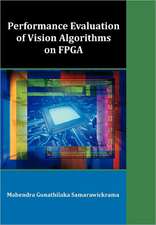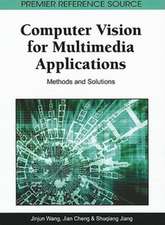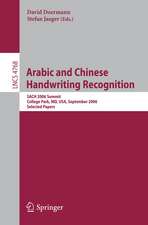Chinese Handwriting Recognition: An Algorithmic Perspective: SpringerBriefs in Electrical and Computer Engineering
Autor Tonghua Suen Limba Engleză Paperback – 11 ian 2013
Din seria SpringerBriefs in Electrical and Computer Engineering
- 19%
 Preț: 427.19 lei
Preț: 427.19 lei -
 Preț: 377.35 lei
Preț: 377.35 lei -
 Preț: 380.07 lei
Preț: 380.07 lei -
 Preț: 378.12 lei
Preț: 378.12 lei - 20%
 Preț: 379.08 lei
Preț: 379.08 lei -
 Preț: 377.18 lei
Preț: 377.18 lei - 20%
 Preț: 234.68 lei
Preț: 234.68 lei - 20%
 Preț: 232.43 lei
Preț: 232.43 lei -
 Preț: 378.12 lei
Preț: 378.12 lei -
 Preț: 377.18 lei
Preț: 377.18 lei - 20%
 Preț: 231.41 lei
Preț: 231.41 lei -
 Preț: 377.18 lei
Preț: 377.18 lei -
 Preț: 377.95 lei
Preț: 377.95 lei -
 Preț: 444.74 lei
Preț: 444.74 lei -
 Preț: 382.36 lei
Preț: 382.36 lei -
 Preț: 378.12 lei
Preț: 378.12 lei -
 Preț: 378.92 lei
Preț: 378.92 lei - 20%
 Preț: 232.43 lei
Preț: 232.43 lei -
 Preț: 376.80 lei
Preț: 376.80 lei -
 Preț: 377.35 lei
Preț: 377.35 lei -
 Preț: 377.18 lei
Preț: 377.18 lei -
 Preț: 381.00 lei
Preț: 381.00 lei -
 Preț: 376.43 lei
Preț: 376.43 lei -
 Preț: 377.18 lei
Preț: 377.18 lei -
 Preț: 378.54 lei
Preț: 378.54 lei - 20%
 Preț: 321.20 lei
Preț: 321.20 lei -
 Preț: 377.73 lei
Preț: 377.73 lei -
 Preț: 341.75 lei
Preț: 341.75 lei -
 Preț: 344.25 lei
Preț: 344.25 lei -
 Preț: 379.09 lei
Preț: 379.09 lei -
 Preț: 377.57 lei
Preț: 377.57 lei -
 Preț: 378.71 lei
Preț: 378.71 lei - 20%
 Preț: 321.66 lei
Preț: 321.66 lei - 20%
 Preț: 230.85 lei
Preț: 230.85 lei -
 Preț: 374.30 lei
Preț: 374.30 lei -
 Preț: 375.45 lei
Preț: 375.45 lei -
 Preț: 360.05 lei
Preț: 360.05 lei -
 Preț: 381.43 lei
Preț: 381.43 lei -
 Preț: 378.34 lei
Preț: 378.34 lei -
 Preț: 376.22 lei
Preț: 376.22 lei - 20%
 Preț: 323.99 lei
Preț: 323.99 lei -
 Preț: 380.07 lei
Preț: 380.07 lei -
 Preț: 375.62 lei
Preț: 375.62 lei - 20%
 Preț: 321.20 lei
Preț: 321.20 lei -
 Preț: 377.18 lei
Preț: 377.18 lei - 5%
 Preț: 361.80 lei
Preț: 361.80 lei -
 Preț: 378.12 lei
Preț: 378.12 lei -
 Preț: 375.07 lei
Preț: 375.07 lei -
 Preț: 376.22 lei
Preț: 376.22 lei
Preț: 324.64 lei
Preț vechi: 405.80 lei
-20% Nou
Puncte Express: 487
Preț estimativ în valută:
62.12€ • 65.03$ • 51.40£
62.12€ • 65.03$ • 51.40£
Carte tipărită la comandă
Livrare economică 07-21 aprilie
Preluare comenzi: 021 569.72.76
Specificații
ISBN-13: 9783642318115
ISBN-10: 3642318118
Pagini: 130
Ilustrații: XI, 124 p. 62 illus., 16 illus. in color.
Dimensiuni: 155 x 235 x 17 mm
Greutate: 0.2 kg
Ediția:2013
Editura: Springer Berlin, Heidelberg
Colecția Springer
Seria SpringerBriefs in Electrical and Computer Engineering
Locul publicării:Berlin, Heidelberg, Germany
ISBN-10: 3642318118
Pagini: 130
Ilustrații: XI, 124 p. 62 illus., 16 illus. in color.
Dimensiuni: 155 x 235 x 17 mm
Greutate: 0.2 kg
Ediția:2013
Editura: Springer Berlin, Heidelberg
Colecția Springer
Seria SpringerBriefs in Electrical and Computer Engineering
Locul publicării:Berlin, Heidelberg, Germany
Public țintă
ResearchCuprins
Introduction.- HIT-MW Database.- Integrated Segmentation-Recognition Strategy.- Segmentation-free Strategy: Basic Algorithms.- Segmentation-free Strategy: Advanced Algorithms
Notă biografică
Dr. Tonghua Su has been working in the character recognition field over 10 years. The research group with which Dr. Su has been working released the HIT-MW database, which is now used at over 60 universities/institutes. They are the first group to systematically study the recognition problem of Chinese handwriting and developed the HMM-based recognizer and the PL-MQDF classifier for Chinese handwritten character recognition.
Textul de pe ultima copertă
This book provides an algorithmic perspective on the recent development of Chinese handwriting recognition. Two technically sound strategies, the segmentation-free and integrated segmentation-recognition strategy, are investigated and algorithms that have worked well in practice are primarily focused on. Baseline systems are initially presented for these strategies and are subsequently expanded on and incrementally improved. The sophisticated algorithms covered include: 1) string sample expansion algorithms which synthesize string samples from isolated characters or distort realistic string samples; 2) enhanced feature representation algorithms, e.g. enhanced four-plane features and Delta features; 3) novel learning algorithms, such as Perceptron learning with dynamic margin, MPE training and distributed training; and lastly 4) ensemble algorithms, that is, combining the two strategies using both parallel structure and serial structure. All the while, the book moves from basic to advanced algorithms, helping readers quickly embark on the study of Chinese handwriting recognition.
Caracteristici
The first monograph available on the recognition of Chinese handwriting texts A systematic sampling mechanics is presented for Chinese handwriting A further reading list with literature analysis is devoted to help readers quickly overview the state-of-the-art Include scalable learning methods for large category learning tasks with inspiring results Includes supplementary material: sn.pub/extras























